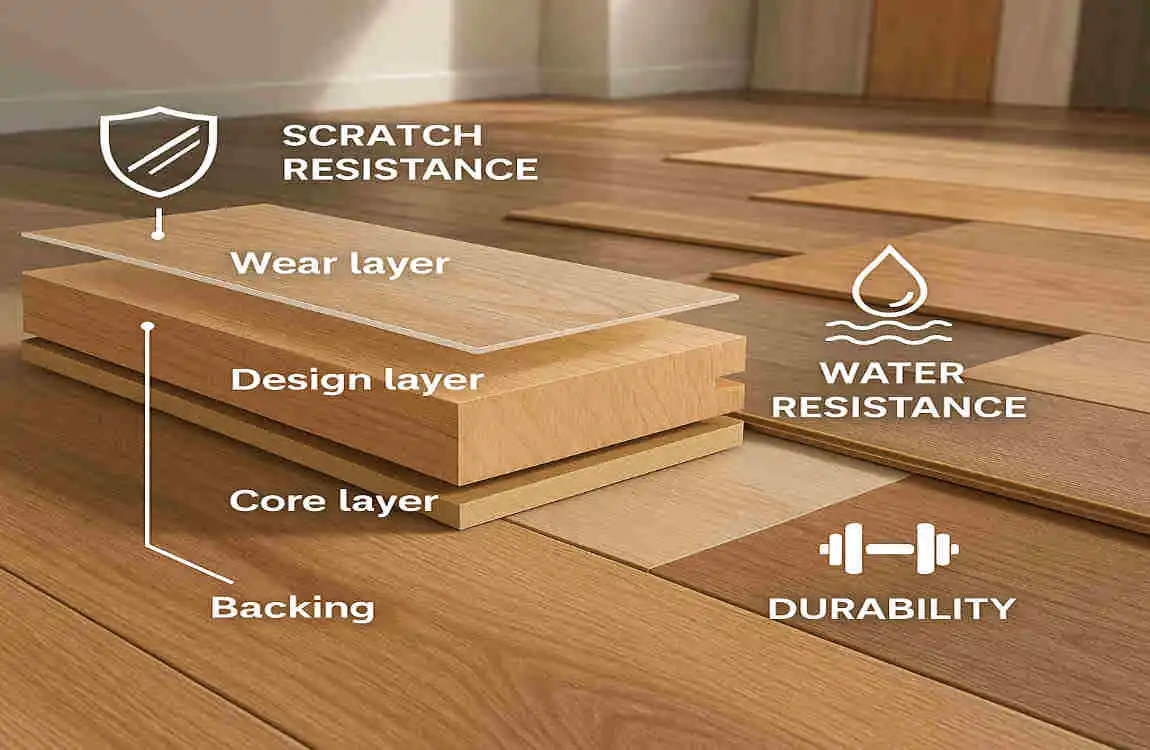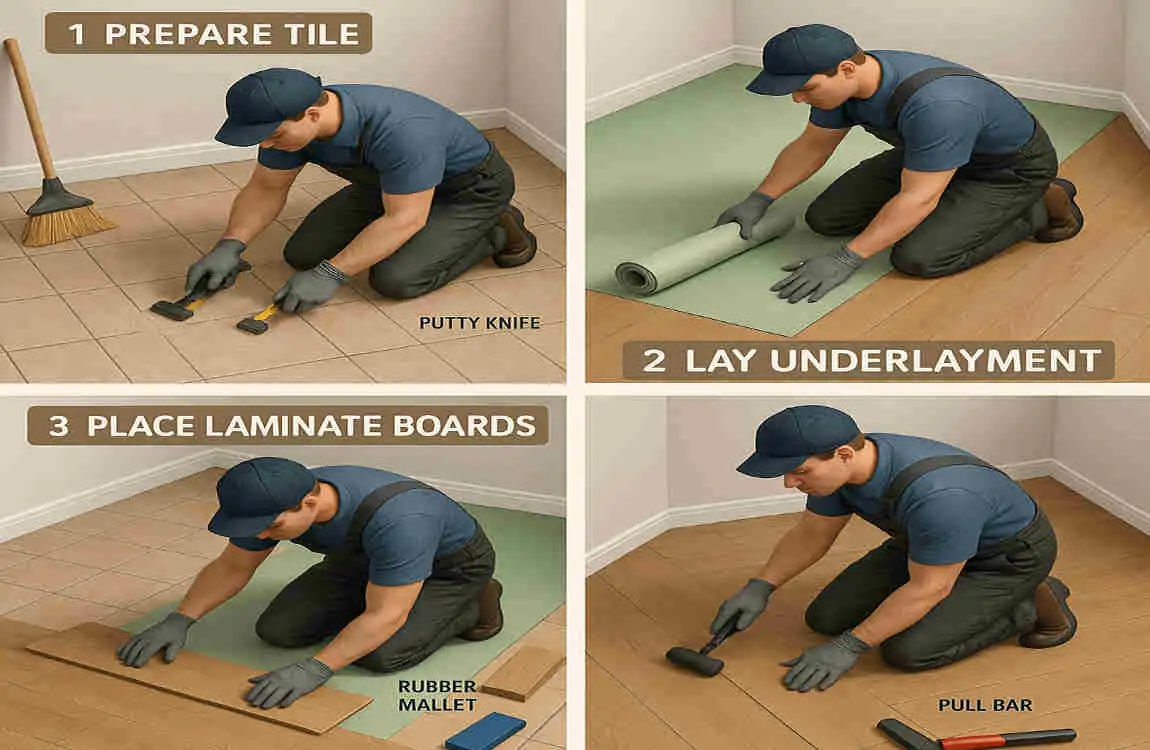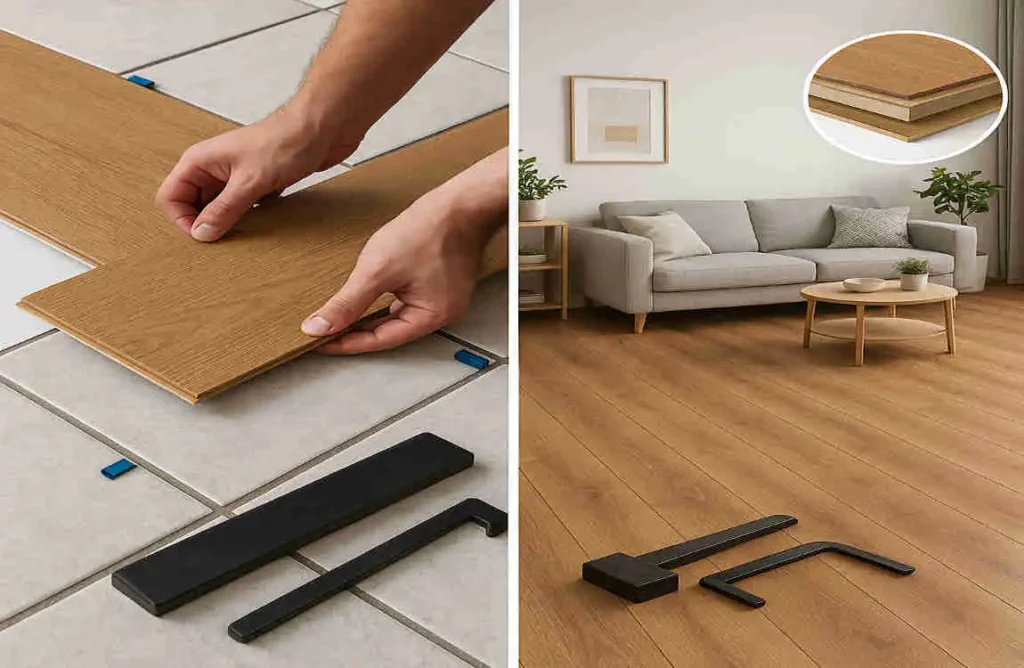Are you thinking about giving your home a fresh new look? One of the most impactful ways to do that is by upgrading your flooring. With so many options available, it can be overwhelming to decide which direction to take.
Understanding Laminate Flooring and Tile Flooring

Before we dive into the specifics of installing laminate over tile, let’s take a moment to understand these two flooring options.
What is Laminate Flooring?
Laminate flooring is a popular choice for many homeowners due to its affordability, durability, and wide range of styles. It’s composed of multiple layers, including a high-resolution image layer that replicates the appearance of real wood, stone, or tile. The top layer is a protective wear layer that makes the laminate resistant to scratches, stains, and fading. Laminate is known for being easy to install, as it typically uses a click-lock system that allows for a floating floor installation.
What is Tile Flooring?
Tile flooring is available in a variety of materials, including ceramic, porcelain, and natural stone. It’s prized for its durability, water resistance, and classic aesthetic appeal. Tiles are usually installed using a thin-set mortar and grout, which creates a strong bond between the tiles and the subfloor. Tile flooring can last for decades with proper care and maintenance.
Differences in Installation Methods
The installation methods for laminate and tile flooring differ significantly. Laminate typically uses a floating floor system, where the planks are clicked together without being directly attached to the subfloor. In contrast, tile is usually adhered directly to the subfloor using mortar. These differences in installation methods play a crucial role in determining whether laminate can be installed over tile.
How These Differences Affect Overlay Possibilities
The floating nature of laminate flooring makes it a good candidate for installation over existing flooring, including tile. Since laminate doesn’t require glue or nails, it can be laid directly over a clean and level tile surface. However, the condition and type of tile, as well as the subfloor beneath it, will impact the success of this overlay method.
Can You Put Laminate Flooring Over Tile?
Now, let’s address the main question: Can you put laminate flooring over tile? The short answer is yes, in many cases, you can install laminate flooring directly over tile. However, there are some important conditions and considerations to keep in mind.
Why Laminate Can Be Installed Over Tile
Laminate’s floating floor system allows it to be installed over a variety of subfloors, including tile. As long as the tile is in good condition, clean, and level, laminate can be laid directly on top of it. This method can save time, money, and effort compared to removing the existing tile before installing new flooring.
Potential Challenges When Layering Laminate Over Tile
While installing laminate over tile is possible, there are some challenges to be aware of. The added height of the laminate flooring can create issues with door clearances and transitions between rooms. Additionally, if the tile is uneven or damaged, it may need to be repaired or leveled before installing the laminate. Moisture concerns and the potential for hollow sounds or creaking are also factors to consider.
Importance of Surface Condition of Existing Tile
The condition of your existing tile floor is crucial when considering installing laminate over it. The tile should be securely attached to the subfloor, free of cracks or loose pieces, and as level as possible. Any issues with the tile should be addressed before proceeding with the laminate installation to ensure a successful outcome.
Benefits of Installing Laminate Over Tile
There are several advantages to installing laminate flooring over your existing tile.
Cost-Effectiveness of Avoiding Tile Removal
One of the biggest benefits of installing laminate over tile is the cost savings. Removing tile can be a labor-intensive and expensive process, often requiring specialized tools and professional help. By installing laminate directly over the tile, you can save on both time and money.
Time Savings in Renovation Projects
Installing laminate over tile is generally a quicker process than removing the tile and starting from scratch. This can be especially beneficial if you’re working with a tight timeline or if you want to minimize the disruption to your daily life during the renovation.
Less Mess and Disruption in the Home
Removing tile can create a significant amount of dust, debris, and mess in your home. By choosing to install laminate over the existing tile, you can avoid this mess and keep your home cleaner during the renovation process.
Improved Warmth and Comfort Compared to Cold Tile
Tile flooring can be notoriously cold underfoot, especially in cooler climates or during the winter months. Laminate flooring, on the other hand, offers a warmer and more comfortable walking surface. By installing laminate over your tile, you can enjoy the benefits of a cozier floor without having to remove the existing tile.
Aesthetic Upgrade and Style Options with Laminate
Laminate flooring comes in a wide variety of styles, colors, and patterns, allowing you to completely transform the look of your space. Whether you want the look of hardwood, stone, or even unique designs, there’s a laminate option to suit your taste. By installing laminate over your existing tile, you can give your home a fresh new look without the hassle and expense of a full flooring replacement.
Assessing Your Existing Tile Floor Before Installation
Before installing laminate over your tile, it’s essential to thoroughly assess the condition of your existing floor. This step will help you determine if your tile is suitable for an overlay and identify any issues that need to be addressed before proceeding.
Inspecting Tile Condition: Cracks, Looseness, Unevenness
Carefully examine your tile floor for any signs of damage, such as cracks, chips, or loose tiles. Uneven areas or significant height variations between tiles should also be noted. These issues may need to be repaired or leveled before installing the laminate to ensure a smooth and stable surface.
Cleaning and Prepping the Tile Floor Thoroughly
A clean and well-prepared tile surface is essential for a successful laminate installation. Thoroughly clean the tile to remove any dirt, grime, or old adhesives. If necessary, use a floor cleaner specifically designed for your type of tile. Once the tile is clean, allow it to dry completely before proceeding with the installation.
Measuring Height Concerns and Transition Thresholds
When installing laminate over tile, it’s important to consider the added height this will create. Measure the thickness of your laminate planks and underlayment to determine the height that will be added to your floor. This information will help you assess potential issues with door clearances and transitions between rooms or flooring types.
Checking Subfloor Stability Under the Tile
The stability of the subfloor beneath your tile is another crucial factor to consider. If the subfloor is uneven, damaged, or unstable, it may need to be repaired before installing the laminate. In some cases, consulting a professional may be necessary to assess the condition of your subfloor and determine the best course of action.
Preparing Tile Floor for Laminate Installation
Once you’ve assessed your existing tile floor and determined that it’s suitable for an overlay, it’s time to prepare the surface for the laminate installation.
How to Level Uneven Tile Surfaces
If your tile floor has significant unevenness or height variations, you may need to level the surface before installing the laminate. This can be done using a self-leveling compound or by installing a leveling underlayment. Follow the manufacturer’s instructions carefully to ensure a smooth and even surface for your laminate flooring.
Considerations for Moisture Barriers or Vapor Barriers
In areas prone to moisture, such as bathrooms or kitchens, it’s important to consider installing a moisture barrier or vapor barrier between the tile and the laminate. These barriers can help prevent moisture from seeping up through the tile and damaging the laminate. Consult with a flooring professional to determine if a moisture barrier is necessary for your specific situation.
Choosing Appropriate Underlayment for Soundproofing and Cushioning
Underlayment plays a crucial role in the success of your laminate flooring installation over tile. It helps to provide a smooth and even surface, reduce noise, and add cushioning underfoot. When choosing an underlayment, look for products specifically designed for use over tile and that offer soundproofing and cushioning benefits.
Importance of Ensuring a Flat, Clean, and Dry Tile Surface
Before installing the laminate, ensure that your tile surface is flat, clean, and completely dry. Any debris, old adhesives, or moisture on the tile can interfere with the installation and lead to problems down the line. Take the time to thoroughly prepare your tile surface for optimal results.
Step-by-Step Guide to Installing Laminate Flooring Over Tile

Now that you’ve assessed and prepared your tile floor, it’s time to start the laminate installation process. Follow these steps for a successful installation:
Gather Tools and Materials Needed
Before you begin, gather all the necessary tools and materials for your laminate installation. This may include:
- Laminate flooring planks
- Underlayment
- Measuring tape
- Utility knife
- Hammer
- Tapping block
- Pull bar
- Spacers
- Transition strips
- Baseboards or trim (if needed)
Remove Baseboards or Moldings if Necessary
If your existing baseboards or moldings are in the way of the laminate installation, you may need to temporarily remove them to make room for the installation. Use a pry bar and hammer to gently remove the baseboards, taking care not to damage the walls or the baseboards themselves.
Lay Underlayment Over Tile
Start by laying the underlayment over the prepared tile surface. Follow the manufacturer’s instructions for proper installation, ensuring that the underlayment is securely attached and covers the entire floor area. Trim the underlayment as needed to fit around corners and edges.
Installing the Laminate Planks: Floating Floor Method
Begin installing the laminate planks along the longest wall in the room, using spacers to maintain an expansion gap around the perimeter. Click the planks together using the manufacturer’s recommended method, ensuring a tight and secure fit. Continue laying the planks row by row, staggering the joints for added stability.
Cutting and Fitting Laminate Around Edges and Corners
As you approach the edges and corners of the room, you may need to cut the laminate planks to fit. Use a utility knife and a straight edge to score the plank, then snap it along the scored line. For more intricate cuts, a jigsaw may be necessary. Take your time and measure carefully to ensure a precise fit.
Installing Transition Strips Between Rooms or Flooring Types
If you’re transitioning from the laminate flooring to another type of flooring, such as carpet or tile, you’ll need to install transition strips. These strips facilitate a smooth and seamless transition between different flooring types. Follow the manufacturer’s instructions for proper installation of the transition strips.
Reinstalling Baseboards or Trim
Once the laminate flooring is fully installed, you can reinstall the baseboards or trim that you removed earlier. Use a nail gun or finishing nails to secure the baseboards in place, ensuring a tight fit against the new flooring. Fill any nail holes with wood putty and touch up with paint as needed.
Potential Drawbacks and How to Avoid Them
While installing laminate over tile has many benefits, there are some potential drawbacks to be aware of. By understanding these challenges and taking steps to mitigate them, you can ensure a successful and long-lasting flooring installation.
Increased Floor Height: Door Clearances and Thresholds Issues
One of the main concerns when installing laminate over tile is the increased floor height. This can lead to issues with door clearances and thresholds, particularly if the doors are not tall enough to accommodate the added height. To address this, you may need to trim the doors or install new thresholds to create a smooth transition.
Risk of Hollow Sounds or Creaking if Underlayment is Insufficient
If the underlayment used between the tile and laminate is insufficient, you may experience hollow sounds or creaking when walking on the floor. To avoid this, choose a high-quality underlayment specifically designed for use over tile and follow the manufacturer’s installation instructions carefully.
Possible Moisture Trapping Leading to Damage Over Time
When installing laminate over tile, there’s a risk of trapping moisture between the two flooring layers. This can lead to damage over time, such as warping, buckling, or mold growth. To mitigate this risk, ensure that the tile surface is completely dry before installation and consider using a moisture barrier in areas prone to moisture.
When Tile Condition Prevents Overlay
In some cases, the condition of the existing tile may prevent a successful laminate overlay from being applied. If the tile is severely damaged, uneven, or loose, it may need to be repaired or removed before installing the laminate. Always assess the condition of your tile carefully and consult a professional if you’re unsure about its suitability for an overlay.
How Professional Consultation Can Help Mitigate Risks
If you’re unsure about any aspect of installing laminate over tile, it’s always a good idea to consult with a professional flooring installer. They can assess your specific situation, provide guidance on the best course of action, and help mitigate any potential risks. A professional can also ensure that the installation is done correctly, giving you peace of mind and a beautiful, long-lasting floor.
Alternative Flooring Options Over Tile
While laminate is a popular choice for installation over tile, it’s not the only option. Here are a few alternative flooring options to consider:
Vinyl Plank Flooring as Another Overlay Option
Vinyl plank flooring is another excellent choice for installation over tile. Like laminate, vinyl plank flooring uses a floating floor system and can be installed directly over a clean and level tile surface. Vinyl is known for its durability, water resistance, and wide range of styles, making it a versatile and attractive option for many homeowners.
Engineered Hardwood vs Laminate Over Tile
Engineered hardwood flooring is another option to consider when installing over tile. While it’s more expensive than laminate, engineered hardwood offers the beauty and warmth of real wood, along with the added stability necessary for installation over tile. However, engineered hardwood typically requires a more complex installation process and may not be suitable for all tile conditions.
When Tile Removal Might Still Be a Better Choice
Removing the existing tile and starting from scratch may be the best course of action. If the tile is severely damaged, uneven, or contains asbestos, it may be more cost-effective and safer to remove it entirely before installing new flooring. Additionally, if you’re looking to completely change the layout of your space or install a flooring type that requires a specific subfloor, removing the tile may be necessary.
Cost Considerations
When deciding whether to install laminate over tile or remove the tile and start anew, it’s essential to consider the associated costs.
Typical Cost Comparison: Laminate Over Tile vs Tile Removal and New Flooring
Installing laminate over tile is generally less expensive than removing the tile and installing new flooring. The exact cost will depend on factors such as the area size, material quality, and whether you hire a professional or do the installation yourself. On average, you can save between 30 and 50% by choosing to install laminate over tile compared to a full flooring replacement.
Cost of Materials, Tools, and Possible Professional Installation
The cost of materials for a laminate installation over tile will include the laminate planks themselves, underlayment, and any necessary transition strips or trim. You may also need to purchase or rent tools such as a utility knife, hammer, and tapping block. If you choose to hire a professional for the installation, expect to pay an additional $2 to $5 per square foot on average.
Long-Term Maintenance Cost Differences
When considering the long-term costs of your flooring choice, keep in mind that laminate flooring typically requires less maintenance than tile. Laminate is resistant to stains and easy to clean, while tile may require periodic grout cleaning and sealing. Over time, these maintenance costs can add up, making laminate a more cost-effective choice in the long run.
